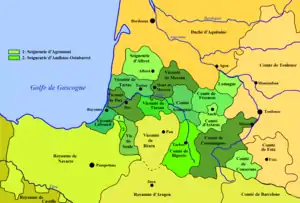Comminges
The Comminges (French: Comminges; Gascon: Comenge) is an ancient region of southern France in the foothills of the Pyrenees, corresponding closely to the arrondissement of Saint-Gaudens in the department of Haute-Garonne. This natural region is normally associated with the former domain of the Counts of Comminges, although an alternate definition is based on the Ancient Diocese of Comminges, which appeared originally to include more of what is now part of Aragon.
Comminges | |
|---|---|
 A valley in Comminges | |
 Duchy of Gascony around 1150. Comté de Comminges shown in dark green at lower right. | |
| Countries | France |
History
- Comminges takes its name from the second part of its Ancient capital Lugdunum Convenarum : Convenae, Latin for 'those gathered', which was founded as a Roman colony in 72 B.C. by the Roman general Pompey, while on the way back to Rome after a military campaign in Spain, to defend the passage to the Aran Valley and the Iberian peninsula. Its flourishing Christian community within the Roman province of Novempopulana got its own bishopric in the late fourth century; it would persist and retain its name, despite the wreck of the city itself during the Germanic invasions.
- The earliest record is from Sidonius Apollinaris who wrote of the persecution suffered by the bishops of Comminges at the hands of the Arian Visigoths in the 5th century. The earliest historically documented Bishop of Comminges, Suavis, assisted at the Council of Agde in 506. The bishops of Comminges had their seat at the future Saint-Bertrand-de-Comminges, so renamed in the 13th century after its canonized bishop Bertrand de l'Isle-Jourdain (1073 – 1123).

Coat-of-arms of Comminges
- Comminges was originally part of Gascony. In 836 García I Galíndez, Count of Aragon, was made Viscount of Comminges and Viscount of Couserans. Around 940, Comminges was divided between the descendants of Aznar II, until reunited in 1012 under Bernard of Comminges. Over the next centuries, the size of the county varied, stretching to Toulouse at times. The small, discontinuous province of Nébouzan was partly contained within the Comminges and its viscounts were vassals of the counts of Comminges.
- Although the county became the property of the French crown in 1498, it retained its identity.
- With the reorganisation of the regions into departments in 1790, Comminges wanted to join its eastern neighbor, the county of Couserans, to form a department but this broke down over arguments about where the prefecture would be located. Eventually Couserans joined with the county of Foix, leaving the Comminges to be joined with the larger county of Toulouse to form the Haute-Garonne département. At the same time the diocese of Comminges was abolished and replaced with a larger diocese aligned with the new department.
- The region still identifies itself as the Comminges and Saint-Gaudens; its largest town calls itself "capital of the Comminges".

The valley of the Comminges
In Film and Television
In 2017, the Netflix TV series The Frozen Dead aka Glacé was filmed in the region.
See also
References
Sources and external links
- La revue de Comminges et des Pyrénées centrales, revue d'études régionales biannuelle de la Société des études du Comminges, depuis 1884 (ISSN 0035-1059)
- Histoire Des Populations Pyrénéennes Du Nébouzan Et Du Pays De Comminges; (editor?) H. Castillon d'Aspet (ISBN 1273711599)
- Société des études du Comminges
| Wikimedia Commons has media related to Comminges. |
This article is issued from Wikipedia. The text is licensed under Creative Commons - Attribution - Sharealike. Additional terms may apply for the media files.